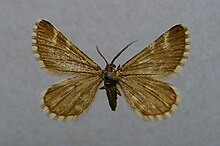Narraga fasciolaria
| Narraga fasciolaria | ||||||||||||
|---|---|---|---|---|---|---|---|---|---|---|---|---|

Narraga fasciolaria , female |
||||||||||||
| Systematics | ||||||||||||
|
||||||||||||
| Scientific name | ||||||||||||
| Narraga fasciolaria | ||||||||||||
| ( Hufnagel , 1767) |
Narraga fasciolaria, sometimes also called Banded Mugwort , is a butterfly ( moth ) fromthe Spanner family (Geometridae).
features
butterfly
The relatively small moths reach a wingspan of 16 to 21 millimeters. Pale yellowish tones predominate on the wings . Four narrow, dark transverse bands stand out gray or brownish on the forewings. The hind wings correspond in color to the forewings and have three dark bands. Sometimes the males are darkly darkened and show only a few drawing elements. The fringes are brown and white piebald. The antennae of the males are combed to the tips, those of the females are thread-shaped.
Caterpillar
Adult caterpillars are green in color and are characterized by thin white side ridge lines as well as equally colored broad side stripes.
Doll
The doll is yellow-brown, finely dotted and shows two diverging tips on the short cremaster .
Similar species
The moths of Narraga tessularia usually show an overall lighter yellow or white colored appearance as well as narrower transverse lines and reach a slightly smaller wingspan (12 to 18 millimeters). A genital morphological examination is recommended for a clear determination .
The caterpillar stage is a good way of differentiating it , as N. fasciolaria only accepts the field mugwort ( Artemisia campestris ) as a forage plant, while N. tessularia lives on beach mugwort ( Artemisia maritima ).
Geographical distribution and occurrence
The distribution area of Narraga fasciolaria extends from eastern areas of Central Europe through Central Asia and southern Russia to East Asia. From Hungary and South Moravia the ssp. Known as Narraga fasciolaria danubialis . The species prefers to inhabit sandy areas, badlands and heaths.
Way of life
The moths are predominantly crepuscular and sometimes fly during the day. They form two generations a year. The first appears from overwintering pupae from May, the second from July after a development time of only two months. The caterpillars feed on the leaves of the mugwort ( Artemisia campestris ). Pupation takes place in a cocoon on the ground.
Danger
In Germany, Narraga fasciolaria can be found predominantly in the eastern federal states and is listed in category 2 (severely endangered) on the Red List of Endangered Species .
swell
Individual evidence
- ^ Günter Ebert (Ed.): The butterflies of Baden-Württemberg. Volume 9. Moths VII. Geometridae 2nd part . 1st edition. Ulmer, Stuttgart (Hohenheim) 2003, ISBN 3-8001-3279-6 .
- ↑ Friedrich Kasy: Halophilic Lepidoptera of the Lake Neusiedl area. In: Negotiations of the Zoological-Botanical Society in Vienna. 98-99, 1959, pp. 13-25 ( PDF (3.6 MB) on ZOBODAT ).
- ↑ Walter Forster, Theodor A. Wohlfahrt: The butterflies of Central Europe. Volume 5: Spanner. (Geometridae). Franckh'sche Verlagshandlung, Stuttgart 1981, ISBN 3-440-04951-5 .
- ↑ Federal Agency for Nature Conservation (Ed.): Red List of Endangered Animals in Germany . Landwirtschaftsverlag, Münster 1998, ISBN 3-89624-110-9 .
literature
- Günter Ebert (Ed.): The butterflies of Baden-Württemberg. Volume 9. Moths VII. Geometridae 2nd part . 1st edition. Ulmer, Stuttgart (Hohenheim) 2003, ISBN 3-8001-3279-6 .
- Walter Forster , Theodor A. Wohlfahrt : The butterflies of Central Europe. Volume 5: Spanner. (Geometridae). Franckh'sche Verlagshandlung, Stuttgart 1981, ISBN 3-440-04951-5 .
Web links
- Lepiforum e. V. Taxonomy and Photos
- www.schmetterlinge-deutschlands.de Endangerment
- Narraga fasciolaria at Fauna Europaea. Retrieved October 19, 2011
